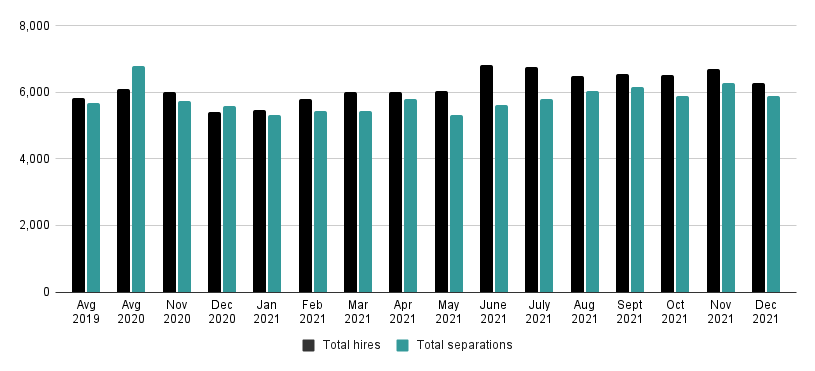Top 10 Ways to Reduce Employee Turnover

On average, a healthy employee turnover rate shouldn’t be over 18% for a business. If it’s over that average, it could damage your business and cost you a lot of money in the long run.
According to the latest reports, the average cost per hire for a non-executive employee in 2021 was $4,425. This was up for $4,129 two years ago. If you’re hiring an executive-level employee, the average cost per hire is around $14,936. Because of this, Recruiter.com expects that companies will see a $50 billion increase spent on hiring in 2022.

However, one way that you can minimize the costs of hiring is by reducing employee turnover rates. Keep reading to discover a few strategies that can help you retain employees.
1. Hire the Right People
While some bad hires are inevitable, recruiters should focus on hiring the right people. To ensure recruiters hire the right people, businesses and hiring managers should communicate what they need regarding employees. However, most human resources departments can find the right hire by having an ideal candidate profile in mind before they start the recruiting process.
That starts with writing a good job description. Hiring managers should be clear about what qualifications a candidate needs and what the job responsibilities are. You don’t want to put the wrong responsibilities or leave out essential details and have a candidate accept a job only to find out that it’s nothing like what they anticipated.
You may also want to consider letting certain peers in the department have a say in the hiring decision. If the coworkers don’t feel that candidate will be a good fit for the company culture or team, it may not be a good hire. Sometimes all of this can be done through a video interview, but if you have a physical office, you can invite the candidate to tour the building and briefly meet the team. This also gives the candidate a chance to see if they would fit in with their future team.
2. Have Team-Building Workshops
When you do hire the right candidate, you’ll want to ensure that they have strong bonds with their coworkers. This can improve employee engagement, which is directly linked to high retention rates. Plus, when teams feel more connected, they can be more productive as well.
If employees feel they have strong friendships at work, they’ll be more hesitant to leave the company and look for a new job. You can help foster this by creating a buddy system for new hires. This way, they have someone to connect with when they first arrive, and then the team-building workshops can help new hires meet new people.
While this is much easier in a physical office, you can still do it in a remote setting.
3. Focus on Employee Happiness
Employee happiness is essential for your company’s retention rate, but when your employees are happier, the employee morale will be higher. And when the morale is higher, then this will mean that your employees are likely to stick around for a while.
Investing in your employee’s happiness can help boost retention rates, which will help you save on hiring costs and improve your profits in the long run.
4. Offer Good Pay and Benefits
During the Great Resignation, many employees realized they could get more pay by hopping jobs rather than staying loyal to one company for years. Companies that want to mitigate this will have to offer good pay and benefits. Not only will this help attract talent that will stay for more than a year, but it can also retain current employees and keep them from shopping around for different jobs.
With inflation rising and recession fears looming, many people are desperate to find a way to cover the extra price of housing, gas, and groceries. You may want to evaluate all of the salaries at the company and adjust if necessary. If you don’t find extra money to pay your employees enough, a different company will.
To ensure that you’re offering competitive rates, you should do some market research on different wages. If you can, figure out what your competitors are paying for similar jobs in your area. This will give you an idea of what type of salary you’ll need to provide.
In addition to salary, you should also be offering good benefits packages. This can sometimes help, primarily if you can’t provide a higher salary than average. You can offer competitive benefits like better health care packages, paid time off, sick time, or flexible work schedules.
5. Offer a Career Path
Many employees want to move along in their careers and don’t want to stay in one job forever. If they don’t feel like you can provide any career movement, they’ll start looking for a new job that will increase their knowledge and skills to move up the ladder. If you can show your employees that there is a career path with your company, they may be willing to move up in your business.
For some employees, they might need to move upward or take a position that is a lateral move. You may even want to keep employees in that position and provide them with more responsibility or training. Communicating it with your employees would be best, so they know what to expect.
6. Give Feedback
When you give feedback to your employees, they’ll be able to assess their job performance and see where they could improve. When you provide employee feedback, even if it’s constructive criticism, you show that you care about them and want them to do better.
However, while giving feedback, you can also acknowledge what their strengths are and figure out what some areas for improvement will be. This can help improve employee turnover rates but also the employee’s motivation and increase employee retention as well.
While giving feedback to your employees is essential, ensure that you also take feedback from employees. When you get their feedback, ensure you listen and incorporate some of it if you can.
7. Offer Flexible Solutions
The COVID-19 pandemic has offered many employees the opportunity to have flexible schedules and working conditions, and many of them don’t want to give that up. If you can provide a relaxed, positive work environment that is remote, then you should do so. If you don’t, many employees will leave and try to find in the employment market a job that suits their lifestyle better.
In addition to that, you should also consider offering flexible schedules. Many employees no longer want to work a standard 9 to 5 schedule. They don’t want to be limited to working a certain amount of hours each day but would instead work on a schedule that works best for their lifestyle.
You can try offering these flexible schedules, and you may be surprised at how much more productive employees are when they can work at the times they feel most productive.
8. Share Your Company’s Vision
Does your company have a clear vision? If employees aren’t sure where your company is headed or what you’re trying to accomplish, they may have difficulty getting on board with you. They may want to work for a company that has clear goals and can provide attainable goals and targets.
You should have a vision that inspires your employees to do their best and feel like they’re a part of something. Your employees might be less engaged when you don’t have a clear vision or goal.
9. Reward Growth
When your employees do grow, make sure that you reward them. Whether that’s with a salary increase, more paid time off, or other training resources, it’s crucial to show employee recognition for those accomplishments.
This doesn’t mean an employee will want to stay with you, but it can help them see that this is a supportive company that cares about their growth and career path.
10. Have a Good Onboarding Process
Onboarding is one of the essential steps in introducing a new employee to your company. If you have a bad onboarding process, you’ll work even harder to keep an employee at your organization.
You should ensure that your onboarding process provides new hires with all the information and resources they’ll need to succeed at your company. Make sure you take time to introduce them to all of their new coworkers.
Discover More Ways to Reduce Employee Turnover
These are only a few ways to reduce a high employee turnover, but there are many other employee retention strategies that you can use.
Keep in mind that it’s impossible to eliminate employee turnover. But you can help reduce your hiring costs by partnering with our recruiting experts. We offer many different recruiting solutions that can help you reduce your cost per hire and time to hire.
Contact us today to find out what type of recruiting solution would be best for your company.
Get the top recruiting news and insights delivered to your inbox every week. Sign up for the Recruiter Today newsletter.
